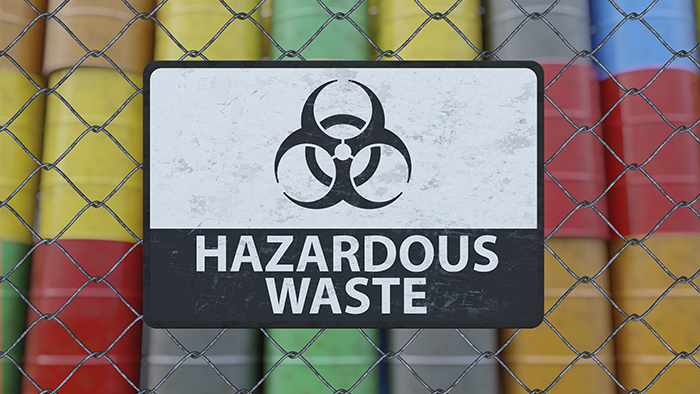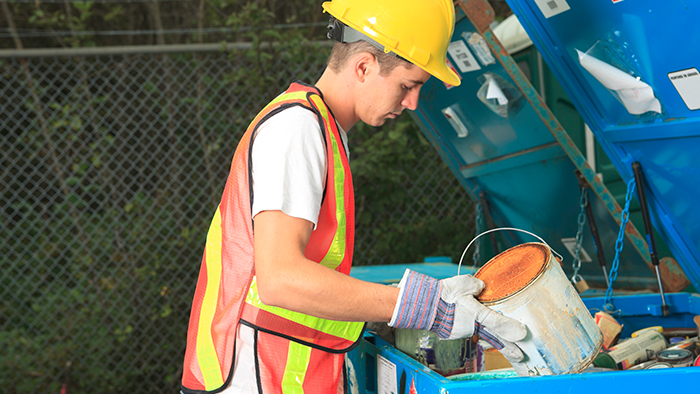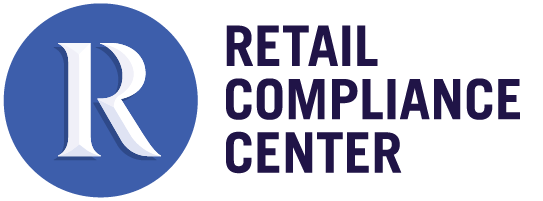Hazardous Waste Regulations
Almost all retail stores – including grocery stores, home improvement stores, convenience stores, and drug stores – may produce hazardous waste. Returned or expired chemicals, spilled cleaning products like bleach, damaged aerosol cans, and even used fluorescent bulbs may need to be managed as hazardous waste. Even though you may generate only a small volume of hazardous waste, the fines for hazardous waste noncompliance can still add up.
This area covers the proper management and disposal or recycling of hazardous and universal wastes. Hazardous wastes include any waste that can be dangerous or potentially harmful to our health or the environment. Hazardous wastes can be liquids, solids, or contained gases that have certain properties, such as being toxic or flammable. Typical examples of hazardous wastes that a retail facility might generate include batteries, mercury-containing equipment, returned or damaged products like pesticides, some cleaning products and some cosmetics, aerosol cans, and cleaning materials such as solvent rags or concentrated cleaners. Some expired pharmaceuticals may also be considered hazardous waste, and are discussed in the RCC Pharmacy Department page.
Compliance Considerations
At the federal level, the Resource Conservation and Recovery Act (RCRA) governs the management of hazardous wastes. RCRA does not provide a single list of all hazardous wastes. It lists some specific wastes that are considered hazardous and provides guidance on how to identify "characteristic" hazardous wastes. The majority of hazardous wastes generated at a retail location are likely to fall into three categories under RCRA. The first are called characteristic wastes and include materials which are corrosive, ignitable, toxic, or reactive. The remainder would generally be what are called "P-listed" and "U-listed" (discarded commercial chemical products) waste. The P and U lists are specifically listed in the regulations and include specific commercial chemical products in an unused form, including some pesticides and some pharmaceutical products.
Many states are authorized to implement the RCRA program and state regulations can be more stringent than the federal requirements. The RCC has a matrix showing some of the differences in state programs and one with variations in hazardous waste reporting requirements.
What is a Hazardous Waste?

RCRA hazardous wastes include discarded material (garbage, refuse, some recyclable materials, sludge, or other discarded material including solids, semisolids, liquids, and contained gaseous materials) that pose a significant threat to public health or the environment. Wastes are defined as hazardous by EPA if they are specifically named on one of the four lists of hazardous wastes or if they exhibit one of four characteristics. State regulations may designate additional hazardous waste characteristics or lists of hazardous wastes.

Haz Waste Generator Improvement Rule Matrix
View Matrix
Hazardous Waste Generator Reporting
View MatrixUniversal Waste
Universal waste is a subcategory of hazardous waste. At the federal level, universal waste includes: batteries, some recalled and unused pesticides, mercury-containing equipment (e.g., thermostats), lamps (e.g., fluorescent bulbs), and aerosol cans. EPA allows facilities to manage these waste streams as universal instead of hazardous to make the process easier. For example, a facility does not have to include the universal waste weight when determining their hazardous waste generator status (discussed below), and is allowed to store universal waste on site for up to one year.
States may impose additional requirements on these wastes (except for some battery types designated under federal law) and may also allow other types of hazardous wastes to be managed under that state's universal waste regulations. The RCC Hazardous Waste Matrix has information on state universal waste variations.
Hazardous Waste Variations by State
View MatrixHazardous Waste Determinations
All facilities should know what is commonly in their waste and recycling. Before disposing or recycling of something that might be hazardous, a waste determination should be made. (Remember, many common household products may be considered hazardous waste.) There are many ways to complete waste determinations, including generator knowledge (e.g., based on Safety Data Sheets (SDS) or experience), analytical testing for one of the four characteristics, or a review of the hazardous waste lists in the regulations. Your state may also have additional characteristic or listed hazardous wastes. Be sure to consult your state's environmental protection web page when making a determination.
Once you have determined if your waste is hazardous, you should check to see if it has been excluded or exempted. For example, EPA exempts alcoholic beverages that have less than 24% alcohol by volume from the hazardous waste rules. Additionally, many types of solvent rags have been given an exemption as long as certain conditions are met. EPA's web page on the criteria for the definition of solid waste and solid and hazardous waste exclusions inlcudes a decision tree for identifying hazadous waste.
Hazardous Waste Generators
Once you have determined that your facility generates hazardous waste, you need to know how much hazardous waste is generated and the frequency. At the federal level, Hazardous Waste Generators are divided into three categories based upon the quantity of waste. Your state may have different or additional categories. The federal categories are:
- Large Quantity Generators (LQGs) generate 1,000 kilograms per month or more of hazardous waste, more than 1 kilogram per month of acutely hazardous waste, or more than 100 kilograms per month of acute spill residue or soil.
- Small Quantity Generators (SQGs) generate more than 100 kilograms, but less than 1,000 kilograms, of hazardous waste per month.
- Very Small Quantity Generators (VSQGs) generate 100 kilograms or less per month of hazardous waste, or 1 kilogram or less per month of acutely hazardous waste, or 100 kilograms or less per month of acute spill residue or soil.
Each class of generator must comply with its own set of requirements (which include the level of required training, waste accumulation time limits, and storage and manifest requirements). SQGs and LQGs must also submit a Notification of RCRA Subtitle C Activities- Instructions and Form (Form 8700-12) to the EPA and state to obtain an EPA ID number. Some states also require VSQGs to notify. For more information on these requirements, see the EPA Hazardous Waste Generator Regulatory Summary Table.
Additionally, most states are authorized to implement the RCRA program and can have categories of hazardous waste generators that are different from the federal categories, see the State Differences in Hazardous Waste Generator Categories.
Hazardous Waste Generator Requirements
The EPA has Guidance on federal requirements for each generator size. In general, this includes ensuring that the waste is stored in compatible containers, is properly labeled with the words "hazardous waste" and the name of the waste, and that there is adequate space to ensure containers can be inspected. There are additional inspection, training, record keeping, and reporting requirements depending on your generator status. In general, the lower the generator status the fewer requirements. States may impose different obligations on generators for training, accumulation, reporting, and other requirements for managing hazardous waste.
Hazardous Waste Manifests and Shipping
All hazardous waste shipments initiated by LQGs and SQGs must have a manifest. For SQGs and LQGs, personnel signing the hazardous waste manifests must be trained before they can sign manifests and need a refresher every three years. Before signing, you should check the information entered on the manifest to ensure that it is accurate and complies with the applicable DOT regulations. When signing a hazardous waste manifest, you certify that the materials listed on the manifest are properly classified, described, packaged, marked, and labeled, and are in proper condition for transportation according to DOT regulations. You are responsible for ensuring the hazardous waste transporter/hauler has an EPA ID Number and that the waste reaches the destination facility. Some states may impose additional requirements for hazardous waste transporters and/or require hazardous waste manifests for VSQGs.
Sustainability and Reducing Compliance Risk
Because RCRA is a complex regulation with potentially significant risks, understanding the regulations and developing a strong compliance program can reduce your regulatory risk.
In addition, reducing the amount of hazardous waste generated can reduce regulatory requirements, thus making compliance easier and less expensive. Hazardous waste can be reduced by reducing the amount of waste (fewer returned items, changing processes to reduce waste generated) or reducing materials that are considered hazardous if they become a waste (using cleaning products that are not hazardous and selecting merchandise that will not become a hazardous waste).
Relevant Content
Hazardous Waste Generator Improvement Rule Matrix
State-by-state tracking of implementation of the Hazardous Waste Generator Improvement Rule.
Hazardous Waste Variations by State Matrix
Overview of state variations in hazardous waste regulations under RCRA, including hazardous waste characteristics, thresholds, and universal waste.
Emergency Generator Permitting Matrix
State-by-state summary of permitting options and exemptions for emergency generators, including general permits and construction operation permits.
Variations In Hazardous Waste Generator Reporting
Overview of variations in hazardous waste reporting by state for routine periodic reporting and requirements for manifest submissions.
Emergency Generator Fact Sheet
Detailed look at emergency generator air regulations including regulatory requirements and federal compliance options.
Pharmacy
Regulatory areas for pharmacy including hazardous waste, DEA-controlled substances, reverse distribution, and drain disposal.
Tags
-
Hazardous Waste
-
Hazardous Waste Overview



